|
|
“Completed rocket static fire with all systems green this time. Launch window opens in 10 days,” Elon Musk tweeted Thursday evening, providing a link to the video above of the brief static fire of the Falcon 9’s first stage at Vandenberg Air Force Base in California. Musk had previously said that the need to perform another static fire, along with other activity at Vandenberg, would push back the Falcon 9 v1.1 launch to September 29-30.
Meanwhile, the missile test Musk alluded to over the weekend as another reason for the delay is now a little better understood: the Vandenberg website now lists a Minuteman III in the early morning hours Sunday.
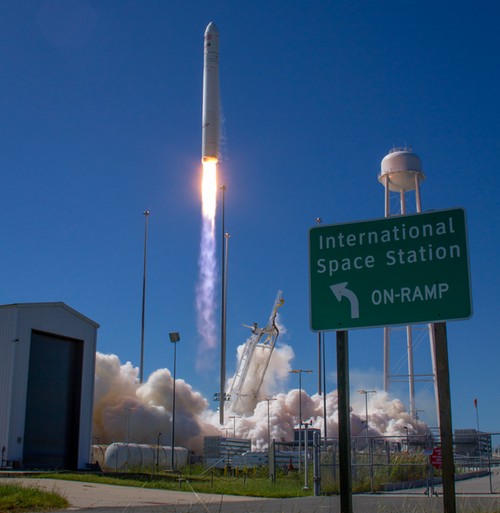 An Antares rocket, carrying a Cygnus cargo spacecraft, lifts off Wednesday from the Mid-Atlantic Regional Spaceport in Virginia, en route to the ISS. (credit: NASA/Bill Ingalls) Orbital’s Cygnus cargo spacecraft is now on its way to becoming the second commercial cargo vehicle to service the International Space Station. The Antares rocket carrying the Cygnus cargo spacecraft lifted off on schedule at 10:58 am EDT (1458 GMT) Wednesday and placed the Cygnus spacecraft into earth orbit. The countdown and launch went well: the only concern was during a time in the countdown when it appeared that, in a worst-case scenario, a launch failure could, given atmospheric conditions, create enough overpressure that occupants of several houses were asked, if they were home. to stand outside in the event windows broke. (As it turned out, the concern subsided and, of course, there was no explosion.)
Since launch, Cygnus has been going through its paces. The spacecraft performed overnight “free drift and abort” demonstrations, the first of ten milestones for the spacecraft as it proceeds to the station, and also carried out two orbit-raising engines burns. A third thruster burn is planned for Thursday afternoon. If everything continues on schedule—something that can’t be guaranteed on a test flight, although everything has gone well so far—Cygnus will arrive at the ISS and be grappled by the station’s robotic arm as early as 7:25 am EDT (1125 GMT) Sunday.
Once there, Cygnus will remain attached to the station for 30 days before departing for a destructive reentry. The spacecraft is carrying 700 kilograms of supplies, more than any previous commercial cargo mission to the station, Orbital’s Frank Culbertson said at a post-launch press conference (a subtle dig at SpaceX’s three Dragon flights to the station.) Culbertson added Orbital would be ready to fly another Cygnus mission, the first of eight under a commercial resupply contract with NASA, as early as December, although NASA officials said they will make a decision on whether Orbital or SpaceX will fly in the December launch opportunity after this test flight.
There’s been no formal announcement from SpaceX, but it appears that the Falcon 9 v1.1 launch that had slipped from Sunday is now postponed to the end of this month. SpaceX CEO Elon Musk tweeted this early Sunday:
Vandenberg Air Force Base, where the launch is taking place, is also used by the Air Force for test launches of ICBMs; Musk’s comment indicates that the range is reserved for those launches until late September.
Late Thursday night, Musk said the launch date was to be determined (TBD) because of unspecified anomalies with a hot fire test of the rocket on the pad Thursday. The Canadian Space Agency, the customer of the rocket’s primary payload, CASSIOPE, said Friday the launch was still on for Sunday, then said the launch was postponed with no new date announced.
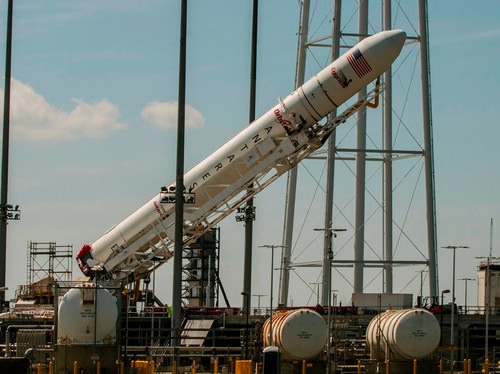 An Antares rocket carrying a Cygnus cargo spacecraft is raised into position on the launch pad in Virginia on Friday. (credit: Orbital Sciences Corp.) While many have been keeping a close eye on SpaceX’s upcoming Falcon 9 v1.1 launch, it’s not the only significant impending commercial launch. On the opposite coast from Vandenberg, Orbital Sciences Corporation is getting ready for the second launch of its Antares rocket from Virginia’s Mid-Atlantic Regional Spaceport (MARS), carrying its first Cygnus cargo spacecraft. The mission is the final milestone in Orbital’s Commercial Orbital Transportation Services (COTS) agreement from NASA, and success will allow the company to being commercial cargo missions to the ISS as soon as December.
The launch was scheduled for Tuesday, but a minor problem has slipped the launch a day. Orbital said Saturday morning that a combination of a delayed rollout of the Antares to its launch pad on Friday (because of weather) and the discovery of a communications problem between the rocket’s computer and ground equipment would push the launch to Wednesday. That communications problem has been traced to a faulty cable between the rocket and ground equipment that Orbital is replacing. Launch is scheduled for a window of 10:50-11:05 am EDT Wednesday. Current forecasts call for partly cloudy skies and light winds at MARS on Wednesday.
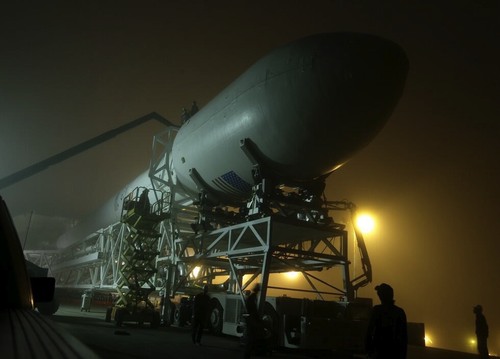 The first SpaceX Falcon 9 v1.1 rolling out to the launch pad at Vandenberg Air Force Base in California earlier this week. Photo tweeted by Elon Musk. After months of waiting, the first launch of the upgraded version of the Falcon 9, called the Falcon 9 v1.1, appears to be imminent. On Tuesday SpaceX rolled the rocket out to its launch pad at Vandenberg Air Force Base in California, with plans to conduct a static fire of the rocket’s first stage engines on the pad before launch. The rollout was captured in a tweet by Elon Musk, including the photo above.
He also pointed to an article by Space News last week where he emphasizes the risks associated with what is, in many respects, a new launch vehicle, with upgraded engines and a stretched first stage. “We’re being, as usual, extremely paranoid about the launch and trying to do everything we possibly can to improve the probability of success, but this is a new version of Falcon 9,” he told Space News. The launch is also the first Falcon 9 mission to use a payload fairing (the previous flew Dragon spacecraft or test articles without a fairing) and also the first from Vandenberg.
“This is awfully exciting for us. It’s a bit of a nail-biter,” said Garrett Reisman, a former astronaut who is project manager for SpaceX’s commercial crew effort, during a panel session at the AIAA Space 2013 conference in San Diego Thursday afternoon. “We’re trying a lot of things for the first time. We’re just going to rip that band-aid off and give it a shot.”
The launch will also test potential reusability of the Falcon 9 first stage by restarting an engine after stage separation to slow the stage’s descent into the ocean. Musk told Space News that he gave the test “maybe a 10 percent chance of success” because of various uncertainties, including whether a landing radar on the stage can detect the ocean surface accurately. Reisman, at the conference agreed. “It’s something that I think, frankly, has a high probability of not being successful, but we’re going to give it a shot.”
When the launch attempt will take place is a little up in the air, though. Official dates on launch manifests, like this NASA one, have slipped from September 5th to the 10th to the 14th to, most recently, the 15th. At a separate panel session at Space 2013 on Tuesday, SpaceX vice president Adam Harris said the launch would take place “in about a week.” (I originally thought he said it would take place in exactly one week, or September 17, but was corrected by both him and the company, who said they plan to launch within the next week.)
At that Tuesday session, Harris said the static fire test on the pad was planned for Wednesday. However, in Wednesday’s conference panel, Reisman said that he learned just before the panel started that the test had been scrubbed for the day. “We have to replan, but likely it will be delayed a little bit,” he said of the launch.
Reisman suggested the launch might slip to Tuesday the 17th, the same day that Orbital is planning to launch its first Cygnus cargo spacecraft on an Antares rocket from Virginia. “You’ll have to watch our launch and Orbital’s launch on a split-screen, which would make for an unbelievably exciting day,” he joked.
“I don’t know if NASA could handle that,” quipped another panelist, Frank Culbertson of Orbital.
Update 9/13: Elon Musk tweeted late Thursday night that the static fire test of the Falcon 9 did take place Thursday, but not without some issues:
However, the Canadian Space Agency, whose CASSIOPE satellite is the Falcon’s primary payload, issued a press release Friday morning stating that the launch is scheduled for Sunday at 12:00 pm EDT (1600 GMT). A CSA spokesperson told Space News they’re waiting for a launch readiness review scheduled for Saturday to confirm the launch date.
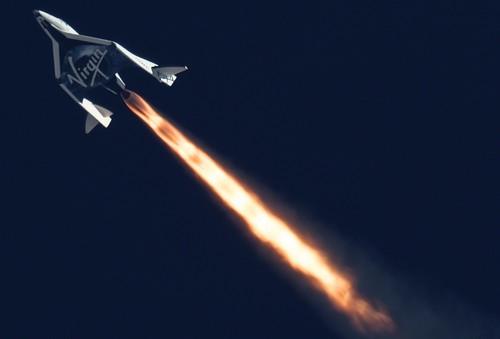 SpaceShipTwo flies on its second powered test flight on September 5. (credit: MarsScientific.com and Clay Center Observatory) SpaceShipTwo did indeed take to the skies on Thursday, performing its second powered flight and the first since late April. SpaceShipTwo fired its hybrid rocket motor for 20 seconds after being released from its WhiteKnightTwo carrier aircraft, reaching a peak altitude of 21,000 meters (69,000 feet) and a top speed of March 1.43, according to a company release. That’s just a little bit more than that April 29 inaugural powered flight, when a 16-second burn sent the vehicle to 16,800 meters (55,000 feet) and Mach 1.3.
There were, though, two more significant differences for this flight. One was that SpaceShipTwo engaged its feathering mechanism, raising and lowering its wings as it would during reentry on a suborbital flight. The feathering system has been used on glide tests, but was not used on the April powered flight. A second change, not mentioned in the Virgin release but noted by Doug Messier, who witnessed the flight, is that the engine plume featured white smoke, not the black smoke seen on the April flight. The reason for, and significance of, that change isn’t known.
Virgin officials and investors hailed the flight as bringing the company another step closer to commercial operations. “We couldn’t be more delighted to have another major supersonic milestone under our belts as we move toward a 2014 start of commercial service,” said Sir Richard Branson. “The successful completion of all major aspects of the flight mission demonstrates that we are very close to achieving one of Galactic’s key goals: commercializing access to space for the broader public,” said H.E. Khadem Al Qubaisi, chairman of Aabar Investments, a major investor in Virgin Galactic.
The company didn’t disclose plans for future test flights in the post-flight statement. Last month, Virgin Galactic CEO George Whitesides said they would increase the engine burn time over successive flights until they reach the full duration (approximately 60 seconds) needed for suborbital spaceflight. “Then we’ll do a few more test missions early next year to simulate the customer experience, then we should be ready to start commercial service,” he said in an August 16 talk at Spaceport America.
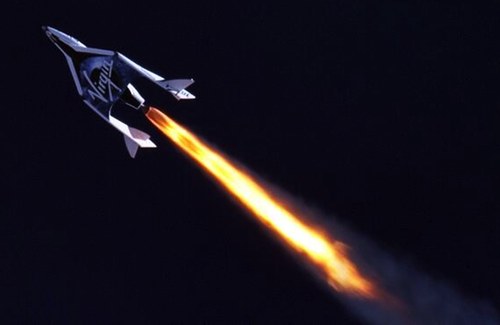 SpaceShipTwo during its first powered test flight on April 29, 2013. (credit: Virgin Galactic/MarsScientific.com) Virgin Galactic’s SpaceShipTwo suborbital vehicle will reportedly make its second powered test flight, and first in more than four months, on Thursday morning. Parabolic Arc, based on Mojave, reported Wednesday night on the expected test flight, with SpaceShipTwo and WhiteKnightTwo being prepared outside their hangar during the day.
If correct, the flight will be the first powered flight for SpaceShipTwo since its inaugural rocket-powered flight on April 29. The long gap since that flight had raised questions in the commercial spaceflight community about whether there were technical issues of some kind with SpaceShipTwo or its hybrid rocket motor; SS2 has performed two glide flights since that April test, most recently on August 8.
On August 16, Virgin Galactic CEO George Whitesides said the company was “gearing up” for its second powered flight test, although he did not give a timeframe then for when it would take place. He said the second and following test flights would feature progressively longer burn times of SS2’s motor; the April test fired the engine for 16 seconds. “Then we’ll do a few more test missions early next year to simulate the customer experience, then we should be ready to start commercial service,†he said. The SS2 powered test flight program would likely be no more than 20 flights, he said last month, adding that there was not a specific number of flights planned and that the actual number would depend on the progress made during the test program.
Update 12:45 pm: The test flight did take place today, and was a success, according to a Virgin Galactic tweet:
 Dream Chaser performs a captive carry flight above Edwards AFB in California on Thursday, suspended under a helicopter. (credit: NASA/Carla Thomas) On Thursday, Sierra Nevada Corporation’s (SNC’s) Dream Chaser spacecraft performed a “captive carry” flight at NASA’s Dryden Flight Research Center at California’s Edwards Air Force Base. During the two-hour test, the Dream Chaser engineering test article (ETA)—a full-sized version of the spacecraft, built for atmospheric tests—flew suspended under a helicopter at altitudes of up to 3,780 meters (12,400 feet). The test checked out a number of components of the vehicle, from its landing gear to its guidance systems.
The test was not the first time the Dream Chaser ETA has been airborne: SNC flew the vehicle during a captive carry test in Colorado in May of last year. This test, though, comes on the heels of a series of taxi tests at Dryden, where a truck towed the vehicle at speeds of up to nearly 100 km/h (60 mph) on the Edwards AFB runway. These tests set the stage for the first glide flight of Dream Chaser, planned for some time this fall (by the end of September, by some accounts.)
Despite these developments, the Dream Chaser remains something of an underdog in NASA’s commercial crew program. Last August, it received one of three Commercial Crew Integrated Capability (CCiCap) awards from NASA, but its award was a “half-sized” award, valued at $212.5 million. The other two awardees, Boeing and SpaceX, received larger awards: $450 million and $440 million, respectively. That has not deterred the company, though. “One of the milestones we had was an internal funding milestone that we just completed,” SNC’s Robert Bell said at the DC-X 20th anniversary event in Alamogordo, New Mexico, last week. “The corporation is still standing behind us as we move forward.”
Earlier this month, SNC also picked up some additional funded milestones to its CCiCap agreement. One milestone, an incremental design review slated for October, is valued at $5 million, while an incremental reaction control system testing milestone planned for next July is worth $10 million; that brings the total funded value of SNC’s agreement to $227.5 million. However, both Boeing and SpaceX also won additional milestones, valued at $20 million for each company.
The window for applying to Mars One to be one of its first one-way astronauts closes at the end of this month. On Wednesday, the organization issued a release with updated figures on the level of interest this has attracted. “With ten days left before the end of its online application program, Mars One has received interest from more than 165,000 people hoping to be the first humans on Mars,” the release stated. Those 165,000-plus people come from 140 countries, with nearly a quarter of them coming from the United States.
It should be noted, though, that this doesn’t mean 165,000 people have completed their applications for Mars One, a mistake that’s easy to make. Note that the press release states that Mars One has “received interest” from 165,000, not received completed applications. Recall back in May that Mars One claimed to have 78,000 applicants, when the information on their web site, in the form of publicly-visible videos from applicants—a key step in the application process—suggested less than 1,000 people had applied. Right now, there are fewer than 1,400 videos on the web site—139 pages of 10 videos each. Applicants, of course, have the option of making their video private, but even if there are significantly more private videos than public ones, it appears that no more than a few percent of that 165,000 have completed applications (and paid a registration fee) for Mars One.
Talking to reporters at the “Million Martian Meeting” in Washington, DC, earlier this month, Mars One CEO Bas Lansdorp acknowledged that the number of completed applications is below the number of people who complete the first step of the process, which involves giving little more than a name, email address, and country. “Not all of those 80,000 applicants have gone through and finished their applications,” he said, referring to last number of potential applications Mars One had released at the time. “A large number of people have dropped out when they found out that they had to pay. There are quite a few people who have not finished their application,” he added, saying he was unsure if they would rush to finish their applications before the August 31 deadline or if they had changed their minds. “Not everybody who applies actually makes it to the end.”
However, he said that even the people who complete that initial registration step, but go no further, still count. “They are people who want to go to Mars,” he said. “We want to call them applicants” because they expressed an interest, even if they decided not to pay the registration fee or complete the application. “These are people who still want to go to Mars and who we consider applicants.”
Once the deadline passes at the end of this month, Mars One will convene a selection board to choose those who go on to the next round, which will require additional medical data and interviews. At the Million Martian Meeting earlier this month, Lansdorp estimated that somewhere between 10 and 30 percent of the applicants in this initial, open stage will make it on to that next round. Two more rounds will follow to come up with six groups of four people each, who will then train for the mission that Mars One hopes to fly in the early 2020s.
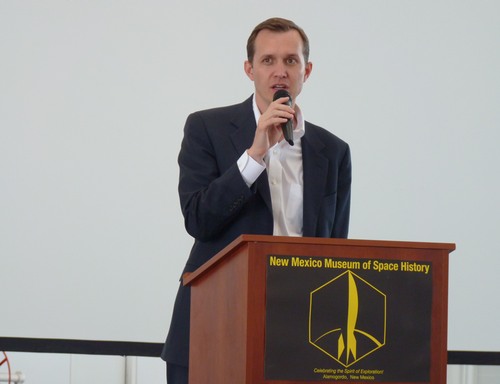 Virgin Galactic CEO George Whitesides speaking Friday at the DC-X 20th anniversary event at Spaceport America in New Mexico. (credit: J. Foust) After a hiatus of more than three and a half months that has raised questions by some industry observers, Virgin Galactic is making preparations for a second powered test flight of its SpaceShipTwo suborbital vehicle, the company’s CEO said Friday.
Speaking at the DC-X First Flight 20th Anniversary and Aerospace Workshop on Friday at Spaceport America in New Mexico, Virgin Galactic CEO George Whitesides indicated that a powered test flight for SpaceShipTwo was upcoming. “We’re gearing up for our second powered flight,” he said, but offered no specifics on the date.
SpaceShipTwo made its only powered flight to date on April 29, firing its hybrid rocket motor for 16 seconds. The vehicle “performed as expected,” the company said at the time, something Whitesides reiterated on Friday. “The first one went very well. We didn’t have any weird ‘flutter’ or anything through supersonic.”
The lack of powered flights since that April test though—SpaceShipTwo has made two glide flights, on July 25 and August 8, according to the vehicle’s public test logs—has generated speculation regarding the long delay. Much of that speculation has focused on the hybrid engine, which has performed two static firings since the April flight, one that Scaled Composites said had flaws “intentionally” introduced into it to test safety systems.
Whitesides said the second and successful powered flights of SpaceShipTwo will fire the engine for longer than April’s 16-second burn. “You’ll see us add time to the burn over the next few test missions,” he said. “Then we’ll do a few more test missions early next year to simulate the customer experience, then we should be ready to start commercial service.” He said later there was not a firm number of powered test flights planned before commercial flights begin. “We have an idea that it’ll be less than 20,” he said, “but we’ll have to see how the test program goes.”
Speaking on Tuesday at the AIAA/USU Conference on Small Satellites in Logan, Utah, Virgin Galactic vice president Will Pomerantz offered a similar view of the state of SpaceShipTwo’s development. “We are now getting really, really close,” he said in a talk devoted primarily to Virgin Galactic’s LauncherOne smallsat launcher. “We’re now looking to be in space, with people but not with paying passengers on the vehicle, by the end of this calendar year, and to begin commercial service, both for our space tourists and for our space researchers and educators, around the middle of next year.”
Whitesides also offered a few comments on Virgin Galactic’s business. He said the company had now signed up about 625 people for suborbital flights, accounting for $125 million in business. That works out to $200,000 per customer, but Whitesides did note that Virgin Galactic had raised its ticket price to $250,000, as the company confirmed back in May. Those customers come from 54 countries, and range from “teenagers to 88 years old,” he said. “We think we can make a really good business out of that.”
|
|








Recent Comments